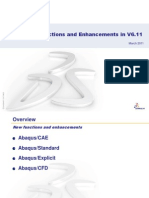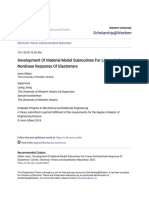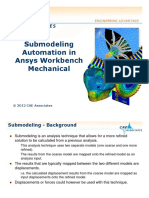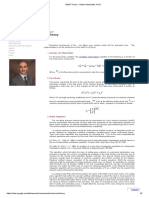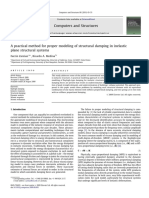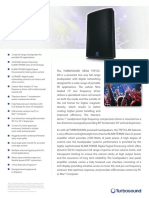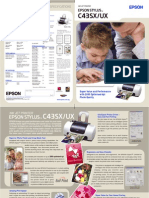ABAQUS User Subroutines Overview
ABAQUS User Subroutines Overview
Uploaded by
Sheng LaiCopyright:
Available Formats
ABAQUS User Subroutines Overview
ABAQUS User Subroutines Overview
Uploaded by
Sheng LaiOriginal Title
Copyright
Available Formats
Share this document
Did you find this document useful?
Is this content inappropriate?
Copyright:
Available Formats
ABAQUS User Subroutines Overview
ABAQUS User Subroutines Overview
Uploaded by
Sheng LaiCopyright:
Available Formats
ABAQUS User subroutines Overview
User subroutines:
are provided to increase the functionality of several ABAQUS capabilities for which the usual data input methods alone may be too restrictive; provide an extremely powerful and flexible tool for analysis; are typically written as FORTRAN code and must be included in a model when you execute the analysis, as discussed below; must be included and, if desired, can be revised in a restarted run, since they are not saved to the restart files (see Restarting an analysis, Section 7.1.1); cannot be called one from another; and can in some cases call utility routines that are also available in ABAQUS (see Utility routines: overview, Section 26.1.1).
Including user subroutines in a model
You can include one or more user subroutines in a model by specifying the name of a FORTRAN source or object file that contains the subroutines. Details are provided in Execution procedure for ABAQUS/Standard and ABAQUS/Explicit, Section 3.2.2. Input File Usage: Enter the following input on the command line:
abaqus job=job-name user={source-file | object-file} ABAQUS/CAE Usage: Job module: job editor: General: User subroutine file
Managing external databases in ABAQUS/Standard and exchanging information with other software
In ABAQUS/Standard it is sometimes desirable to set up the FORTRAN environment and manage interactions with external data files that are used in conjunction with user subroutines. For example, there may be
history-dependent quantities to be computed externally, once per increment, for use during the analysis; or output quantities that are accumulated over multiple elements in COMMON block variables within user subroutines may need to be written to external files at the end of a converged increment for postprocessing. Such operations can be performed with user subroutine UEXTERNALDB (UEXTERNALDB, Section 25.2.21). This user interface can potentially be used to exchange data with another code, allowing for stagger between ABAQUS/Standard and another code.
Writing a user subroutine
User subroutines should be written with great care. To ensure their successful implementation, the rules and guidelines below should be followed. Required INCLUDE statement Every ABAQUS/Standard user subroutine must include the statement include 'aba_param.inc' as the first statement after the argument list. Every ABAQUS/Explicit user subroutine must include the statement include 'vaba_param.inc' as the first statement after the argument list. If variables are exchanged between the main user subroutine and subsequent subroutines, the user should specify the above include statement in all the subroutines to preserve precision. The files aba_param.inc and vaba_param.inc are installed on the system by the ABAQUS installation procedure and contain important installation parameters. These statements tell the ABAQUS execution procedure, which compiles and links the user subroutine with the rest of ABAQUS, to include the aba_param.inc or vaba_param.inc file automatically. It is not necessary to find the file and copy it to any particular directory; ABAQUS will know where to find it. Naming convention
If user subroutines call other subroutines or use COMMON blocks to pass information, such subroutines or COMMON blocks should begin with the letter K since this letter is never used to start the name of any subroutine or COMMON block in ABAQUS. Redefining variables User subroutines must perform their intended function without overwriting other parts of ABAQUS. In particular, you should redefine only those variables identified in this chapter as variables to be defined. Redefining variables passed in for information will have unpredictable effects. Compilation and linking problems If problems are encountered during compilation or linking of the subroutine, make sure that the ABAQUS environment file (the default location for this file is the site subdirectory of the ABAQUS installation) contains the correct compile and link commands as specified in the ABAQUS Installation and Licensing Guide. These commands should have been set up by the ABAQUS site manager during installation. The number and type of arguments must correspond to what is specified in the documentation. Mismatches in type or number of arguments may lead to platform-dependent linking or runtime errors. Testing and debugging When developing user subroutines, test them thoroughly on smaller examples in which the user subroutine is the only complicated aspect of the model before attempting to use them in production analysis work. If needed, debug output can be written to the ABAQUS/Standard message (.msg) file using FORTRAN unit 7 or to the ABAQUS/Standard data (.dat) file or the ABAQUS/Explicit status (.sta) file using FORTRAN unit 6; these units should not be opened by your routines since they are already opened by ABAQUS. FORTRAN units 15 through 18 or units greater than 100 can be used to read or write other user-specified information. The use of other FORTRAN units may interfere with ABAQUS file operations; see FORTRAN unit numbers used by ABAQUS, Section 3.7.1. You must open these FORTRAN units; and because of the use of scratch directories, the full pathname for the file must be used in the OPEN statement. Terminating an analysis
Utility routine XIT (ABAQUS/Standard) or XPLB_EXIT (ABAQUS/Explicit) should be used instead of STOP when terminating an analysis from within a user subroutine. This will ensure that all files associated with the analysis are closed properly (Terminating an analysis, Section 26.2.12).CALL XIT or CALL XPLB_EXIT
Models defined in terms of an assembly of part instances
An ABAQUS model can be defined in terms of an assembly of part instances (see Defining an assembly, Section 2.9.1). Reference coordinate system Although a local coordinate system can be defined for each part instance, all variables (such as current coordinates) are passed to a user subroutine in the global coordinate system, not in a part-local coordinate system. The only exception to this rule is when the user subroutine interface specifically indicates that a variable is in a user-defined local coordinate system (Orientations, Section 2.2.5, or Transformed coordinate systems, Section 2.1.5). The local coordinate system originally may have been defined relative to a part coordinate system, but it was transformed according to the positioning data given for the part instance. As a result, a new local coordinate system was created relative to the assembly (global) coordinate system. This new coordinate system definition is the one used for local orientations in user subroutines. Node and element numbers The node and element numbers passed to a user subroutine are internal numbers generated by ABAQUS. These numbers are global in nature; all internal node and element numbers are unique. If the original number and the part instance name are required, call the utility subroutine GETPARTINFO (ABAQUS/Standard) or VGETPARTINFO (ABAQUS/Explicit) from within your user subroutine (see Obtaining part information, Section 26.2.4). The expense of calling these routines is not trivial, so minimal use of them is recommended. Another utility subroutine, GETINTERNAL (ABAQUS/Standard) or VGETINTERNAL (ABAQUS/Explicit), can be used to retrieve the internal node or element number corresponding to a given part instance name and local number.
Set and surface names Set and surface names passed to user subroutines are always prefixed by the assembly and part instance names, separated by underscores. For example, a surface named surf1 belonging to part instance Part1-1 in assembly Assembly1 will be passed to a user subroutine as Assembly1_Part1-1_surf1
Solution-dependent state variables
Solution-dependent state variables are values that can be defined to evolve with the solution of an analysis. Defining and updating Any number of solution-dependent state variables can be used in the following user subroutines:
CREEP, Section 25.2.1 FRIC, Section 25.2.8 HETVAL, Section 25.2.12 UEL, Section 25.2.19 UEXPAN, Section 25.2.20 UGENS, Section 25.2.24 UHARD, Section 25.2.25 UHYPER, Section 25.2.27 UINTER, Section 25.2.28 UMAT, Section 25.2.30 UMATHT, Section 25.2.31 UMULLINS, Section 25.2.34 USDFLD, Section 25.2.39 UTRS, Section 25.2.42 VFRIC, Section 25.3.2 VUINTER, Section 25.3.3 VUMAT, Section 25.3.4
The state variables can be defined as a function of any other variables appearing in these subroutines and can be updated accordingly. Solutiondependent state variables should not be confused with field variables, which may also be needed in the constitutive routines and can vary with
time; field variables are discussed in detail in Predefined fields, Section 19.6.1. Solution-dependent state variables used in VFRIC and VUINTER are defined as state variables at slave nodes and are updated with other contact variables. Allocating space You must allocate space for each of the solution-dependent state variables at every applicable integration point or contact slave node. Separate user subroutine groups have been identified that differ in the way the number of solution-dependent state variables is defined. These groups are described below. Solution-dependent state variables can be shared by subroutines within the same group; they cannot be shared between subroutines belonging to different groups. Input File Usage: For most subroutines the number of such variables required at the points or nodes is entered as the only value on the data line of the *DEPVAR option, which should be included as part of the material definition for every material in which solution-dependent state variables are to be considered: *DEPVAR For subroutines that do not use the material behavior defined with the *MATERIAL option, the *DEPVAR option is not used. For subroutine UEL: *USER ELEMENT, VARIABLES=number of variables For subroutine UGENS: *SHELL GENERAL SECTION, USER, VARIABLES=number of variables For subroutines FRIC and VFRIC: *FRICTION, USER, DEPVAR=number of variables
For subroutines UINTER and VUINTER: *SURFACE INTERACTION, USER, DEPVAR=number of variables ABAQUS/CAE Us For most subroutines the number of such variables age: required at the points or nodes is entered as part of the material definition for every material in which solutiondependent state variables are to be considered: Property module: material editor: General Depvar: Number of solution-dependent state variables
Defining initial values You can define the initial values of solution-dependent state variable fields directly or in ABAQUS/Standard through a user subroutine. The initial values of solution-dependent state variables for contact in ABAQUS/Explicit are assigned as zero internally. Defining initial values directly You can define the initial values in a tabular format for elements and/or element sets. See Initial conditions, Section 19.2.1, for additional details. Input File Usage: *INITIAL CONDITIONS, TYPE=SOLUTION
Defining initial values in a user subroutine in ABAQUS/Standard For complicated cases in ABAQUS/Standard you can call user subroutine SDVINI so that dependencies on coordinates, element numbers, etc. can be used in the definition of the variable field. See SDVINI, Section 25.2.16, for additional details. Input File Usage: Output User-defined, solution-dependent state variables can be written to the data file (.dat), the output database file (.odb), and the results file (.fil); the output identifiers SDV and SDVn are available as element integration variables (see ABAQUS/Standard output variable identifiers, Section *INITIAL CONDITIONS, TYPE=SOLUTION, USER
4.2.1, and ABAQUS/Explicit output variable identifiers, Section 4.2.2). These variables are not available for user subroutines VFRIC and VUINTER.
Alphanumeric data
Alphanumeric data, such as labels (names) of surfaces or materials, are always passed into user subroutines in the upper case. As a result, direct comparison of these labels with corresponding lower-case characters will fail. Upper case must be used for all such comparisons. An example of such a comparison can be found in UMAT, Section 25.2.30. It illustrates the code setup inside user subroutine UMAT when more than one userdefined material model needs to be defined. The variable CMNAME is compared against MAT1 and MAT2 (even in situations where the material names may have been defined as mat1 and mat2, respectively.)
Precision in ABAQUS/Explicit
ABAQUS/Explicit is installed on all 32-bit floating point word systems with both single precision and double precision executables and on 64-bit floating point word systems as a single precision executable. By default, ABAQUS/Explicit is run in the native precision of the machine. To use the double precision executable on 32-bit machines, you must specify double precision when you run the analysis (see Execution procedure for ABAQUS/Standard and ABAQUS/Explicit, Section 3.2.2). All variables in the user subroutines that start with the letters a to h and o to z will automatically be defined in the precision of the executable that you run. The precision of the executable is defined in the vaba_param.inc file, and it is not necessary to define the precision of the variables explicitly.
Vectorization in ABAQUS/Explicit
ABAQUS/Explicit user subroutines are written with a vector interface, which means that blocks of data are passed to the user subroutines. For example, the vectorized user material routine (VUMAT) is passed stresses, strains, state variables, etc. for nblock material points. One of the parameters defined by vaba_param.inc is maxblk, the maximum block size. If the user subroutine requires the dimensioning of temporary arrays, they can be dimensioned by maxblk.
Parallelization in ABAQUS/Explicit
User subroutines can be used when running ABAQUS/Explicit in parallel. However, the use of common block statements in the user subroutines or in subroutines called by the user subroutines must be avoided since it will result in unpredictable behavior of the executable.
User subroutine calls
Most of the user subroutines available in ABAQUS are called at least once for each increment during an analysis step. However, as discussed below, many subroutines are called more or less often. Subroutines that define material, element, or interface behavior Most user subroutines that are used to define material, element, or interface behavior are called twice per material point, element, or slave surface node in the first iteration of every increment such that the model's initial stiffness matrix can be formulated appropriately for the step procedure chosen. The subroutines are called only once per material point, element, or slave surface node in each succeeding iteration within the increment. By default, in transient implicit dynamic analyses (Implicit dynamic analysis using direct integration, Section 6.3.2) ABAQUS/Standard calculates accelerations at the beginning of each dynamic step. ABAQUS/Standard must call user subroutines that are used to define material, element, or interface behavior two extra times for each material point, element, or slave surface node prior to the zero increment. The extra calls to the user subroutines are not made if the initial acceleration calculations are suppressed. If the half-step residual tolerances are being checked in a transient implicit dynamic step, ABAQUS/Standard must call these user subroutines one extra time for each material point, element, or slave surface node at the end of each increment. If the calculation of the half-step residual is suppressed, the extra call to the user subroutines is not made. User subroutines UHARD, UHYPEL, UHYPER, and UMULLINS, when used in plane stress analyses, are called more often.
Subroutines that define initial conditions or orientations User subroutines that are used to define initial conditions or orientations are called before the first iteration of the first step's initial increment within an analysis. Subroutines that define predefined fields User subroutines that are used to define predefined fields are called prior to the first iteration of the relevant step's first increment for all iterations of all increments whenever the current field variable is needed. Verification of subroutine calls If there is any doubt as to how often a user subroutine is called, this information can be obtained upon testing the subroutine on a small example, as suggested earlier. The current step and increment numbers are commonly passed into these subroutines, and they can be printed out as debug output (also discussed earlier). The iteration number for which the subroutine is called may not be passed into the user subroutine; however, if printed output is sent from the subroutine to the message (.msg) file (Output, Section 4.1.1), the location of the output within this file will give the iteration number, provided that the output to the message file is written at every increment.
ABAQUS/Standard subroutines
CREEP, Section 25.2.1 DFLOW, Section 25.2.2 DFLUX, Section 25.2.3 DISP, Section 25.2.4 DLOAD, Section 25.2.5 FILM, Section 25.2.6 FLOW, Section 25.2.7 FRIC, Section 25.2.8 GAPCON, Section 25.2.9 GAPELECTR, Section 25.2.10 HARDINI, Section 25.2.11
HETVAL, Section 25.2.12 MPC, Section 25.2.13 ORIENT, Section 25.2.14 RSURFU, Section 25.2.15 SDVINI, Section 25.2.16 SIGINI, Section 25.2.17 UCORR, Section 25.2.18 UEL, Section 25.2.19 UEXPAN, Section 25.2.20 UEXTERNALDB, Section 25.2.21 UFIELD, Section 25.2.22 UFLUID, Section 25.2.23 UGENS, Section 25.2.24 UHARD, Section 25.2.25 UHYPEL, Section 25.2.26 UHYPER, Section 25.2.27 UINTER, Section 25.2.28 UMASFL, Section 25.2.29 UMAT, Section 25.2.30 UMATHT, Section 25.2.31 UMESHMOTION, Section 25.2.32 UMOTION, Section 25.2.33 UMULLINS, Section 25.2.34 UPOREP, Section 25.2.35 UPRESS, Section 25.2.36 UPSD, Section 25.2.37 URDFIL, Section 25.2.38 USDFLD, Section 25.2.39 UTEMP, Section 25.2.40 UTRACLOAD, Section 25.2.41 UTRS, Section 25.2.42 UVARM, Section 25.2.43 UWAVE, Section 25.2.44 VOIDRI, Section 25.2.45
ABAQUS/Explicit subroutines
VDLOAD, Section 25.3.1 VFRIC, Section 25.3.2 VUINTER, Section 25.3.3 VUMAT, Section 25.3.4
2 FORTRAN unit numbers used by ABAQUS
ABAQUS uses the FORTRAN unit numbers outlined in the table below. Unless noted otherwise, you should not try to write to these FORTRAN units from user subroutines. You should specify unit numbers 1518 or unit numbers greater than 100.
FORTRAN unit numbers
Code ABAQUS/Stand ard
Unit Description Number 1 2 6 7 8 10 12 Internal database Solver file Printed output (.dat) file (You can write output to this file.) Message (.msg) file (You can write output to this file.) Results (.fil) file Internal database Restart (.res) file
1930 Internal databases (scratch files). Unit numbers 21 and 22 are always written to disk. 73 Text file containing meshed beam cross-section properties (.bsp)
Code ABAQUS/Explicit Analysis
Unit Description Number 6 60 61 62 63 64 Printed output (.log or .sta) file (You can write output to the .sta file.) Package (.pac) file State (.abq) file Temporary file Selected results (.sel) file Message (.msg) file
Code
Unit Description Number 69 Internal database; temporary file Restart (.res) file Communications (.023) file Package (.pac) file State (.abq) file Temporary file Selected results (.sel) file Internal database; temporary file 12 23 60 61 62 63 69
ABAQUS/Explicit Packager
You might also like
- Udr ManualDocument76 pagesUdr ManualΝίκος Μπούλιαρης100% (3)
- Fortran Library of Scientific SubroutinesDocument196 pagesFortran Library of Scientific SubroutinesBasil PolychronopulosNo ratings yet
- A User-Material Subroutine Incorporating Single Crystal Plasticity in The Abaqus Finite Element ProgramDocument47 pagesA User-Material Subroutine Incorporating Single Crystal Plasticity in The Abaqus Finite Element ProgramangrycabbageNo ratings yet
- Manual SAMCEFDocument94 pagesManual SAMCEFDFKLJSFKDLJ100% (1)
- Transition Plan TemplateDocument9 pagesTransition Plan TemplateMike Vaia100% (1)
- Electronics and Communication Interview Questions and AnswersDocument92 pagesElectronics and Communication Interview Questions and Answerssmeena100% (1)
- Fendt 5225 e - My2017 - enDocument122 pagesFendt 5225 e - My2017 - enNicoleta Costea100% (1)
- Mechanics of Building Materials ABAQUS UMAT ImplementationDocument27 pagesMechanics of Building Materials ABAQUS UMAT Implementationapu100% (1)
- Documentation AbaqDocument86 pagesDocumentation AbaqKristi GonzalesNo ratings yet
- Abaqus Fortran IntegrationDocument3 pagesAbaqus Fortran IntegrationHenryNo ratings yet
- Metal Inelasticity in ABAQUS - L3 - Direct Cyclic Procedure PDFDocument7 pagesMetal Inelasticity in ABAQUS - L3 - Direct Cyclic Procedure PDFFahrgerusteNo ratings yet
- General Abaqus ChecklistDocument26 pagesGeneral Abaqus Checklistharshaankalkoti0% (1)
- Abaqus FaqDocument73 pagesAbaqus FaqTaufiq SaidinNo ratings yet
- 2003-06 Optimization Using ABAQUS and TOSCADocument15 pages2003-06 Optimization Using ABAQUS and TOSCAlumasNo ratings yet
- Progressive Damage Simulation Methods For Laminated Composites Using AbaqusDocument65 pagesProgressive Damage Simulation Methods For Laminated Composites Using AbaqusKetan KhamgaonkarNo ratings yet
- Abaqus New Function in V6.11Document121 pagesAbaqus New Function in V6.11DS AlfonsoNo ratings yet
- AdvFem Meshfree 2016classDocument282 pagesAdvFem Meshfree 2016classzack100% (1)
- Structural Design of Corrugated Boxes For Horticultural Produce: A ReviewDocument14 pagesStructural Design of Corrugated Boxes For Horticultural Produce: A ReviewshahiraNo ratings yet
- Scalar and Vectorized User Defined Material Routines in LS-DYNADocument52 pagesScalar and Vectorized User Defined Material Routines in LS-DYNATirumala Rao100% (1)
- Non-Linear Finite Element Method For Solids: Lecture Notes For The Course 4K440Document76 pagesNon-Linear Finite Element Method For Solids: Lecture Notes For The Course 4K440Pablo Tobar PalmaNo ratings yet
- Ansa Model Checks For Ls-DynaDocument5 pagesAnsa Model Checks For Ls-DynaShailesh SainiNo ratings yet
- A Review of T-Stress and Its Effects in Fracture MechanicsDocument24 pagesA Review of T-Stress and Its Effects in Fracture MechanicsMarilene Lobato100% (1)
- Numerical ExamplesDocument20 pagesNumerical ExampleslitrakhanNo ratings yet
- HighStrainRate Recommended Procedure PDFDocument30 pagesHighStrainRate Recommended Procedure PDFSivaraman VisvanathanNo ratings yet
- Abaqus 6.12 GuideDocument192 pagesAbaqus 6.12 GuideWenchen MaNo ratings yet
- Development of Material Model Subroutines For Linear and Nonlinea PDFDocument83 pagesDevelopment of Material Model Subroutines For Linear and Nonlinea PDFPablo Peña TorresNo ratings yet
- 46910: PHD Course in Advanced Finite Element Simulations Using AbaqusDocument44 pages46910: PHD Course in Advanced Finite Element Simulations Using AbaqusMAGED MOHMMED AHMED QASEMNo ratings yet
- Workbench Submodel AutomationDocument17 pagesWorkbench Submodel Automationnils4586No ratings yet
- Buckling, Postbuckling, and Collapse Analysis With Abaqus: About This CourseDocument11 pagesBuckling, Postbuckling, and Collapse Analysis With Abaqus: About This CourseEvgeny ShavelzonNo ratings yet
- Damage and Failure For Ductile MetalsDocument10 pagesDamage and Failure For Ductile Metalsp_rameshreddy2006No ratings yet
- Tutorial I2 - BeamDocument14 pagesTutorial I2 - BeamAna MartinezNo ratings yet
- Damage and Failure For Ductile Metals - Abaqus PDFDocument18 pagesDamage and Failure For Ductile Metals - Abaqus PDFshayan50% (2)
- Abaqus Beam Tutorial: Problem DescriptionDocument29 pagesAbaqus Beam Tutorial: Problem Descriptionpedro paivaNo ratings yet
- Multi-Scale Analyses On Seismic Damage and Progressive Failure ofDocument12 pagesMulti-Scale Analyses On Seismic Damage and Progressive Failure ofMehranVaNo ratings yet
- X-FEM For Abaqus (XFA) Toolkit For Automated Crack Onset and Growth SimulationsDocument1 pageX-FEM For Abaqus (XFA) Toolkit For Automated Crack Onset and Growth SimulationsSIMULIACorpNo ratings yet
- Delamination With AbaqusDocument13 pagesDelamination With AbaqusSchmetterling TraurigNo ratings yet
- UMAT Theory - Nader Abedrabbo, PH.DDocument2 pagesUMAT Theory - Nader Abedrabbo, PH.DSebastiao SilvaNo ratings yet
- Abaqus Analysis User PDFDocument19 pagesAbaqus Analysis User PDFmohammadhossein ramezani100% (1)
- Damping ModelsDocument23 pagesDamping ModelsgarystevensozNo ratings yet
- SAMCEF-Nastran FE InterfacesDocument4 pagesSAMCEF-Nastran FE InterfacesYoungyu ChoiNo ratings yet
- FEM BooksDocument17 pagesFEM BooksRaja KunduNo ratings yet
- Abaqus IntroductionDocument20 pagesAbaqus IntroductionRavi KumarNo ratings yet
- Overview of ABAQUS ExplicitDocument11 pagesOverview of ABAQUS Explicittone_n_tune100% (1)
- l3 MaterialsDocument32 pagesl3 MaterialsZaouiNo ratings yet
- Imp-Thoupal 2009-Mechanics of Mechanically Fastened Joints in Polymer-Matrix Composite Structures - A Review PDFDocument29 pagesImp-Thoupal 2009-Mechanics of Mechanically Fastened Joints in Polymer-Matrix Composite Structures - A Review PDFJamalDilferozNo ratings yet
- 05 Nonlinear Dynamics PDFDocument39 pages05 Nonlinear Dynamics PDFZ R BhattiNo ratings yet
- Damage Evolution LawDocument15 pagesDamage Evolution LawRafael ZanettiNo ratings yet
- Sol Mech 2015Document233 pagesSol Mech 2015Bikash ChoudhuriNo ratings yet
- ME803 Continuum Mech. - Lec 1 - IntroductionDocument26 pagesME803 Continuum Mech. - Lec 1 - IntroductionAsif RahmanNo ratings yet
- A Practical Method For Proper Modeling of Structural Damping in Inelastic Plane Structural Systems PDFDocument9 pagesA Practical Method For Proper Modeling of Structural Damping in Inelastic Plane Structural Systems PDFCarlos Ivan Troncoso OrtegaNo ratings yet
- Durability and Fatigue Life Analysis Using MSC FatigueDocument2 pagesDurability and Fatigue Life Analysis Using MSC FatigueHumayun NawazNo ratings yet
- Samcef RbeDocument13 pagesSamcef RbeKimi KononNo ratings yet
- Damage Mechanics in Metal Forming: Advanced Modeling and Numerical SimulationFrom EverandDamage Mechanics in Metal Forming: Advanced Modeling and Numerical SimulationRating: 4 out of 5 stars4/5 (1)
- Hands-On Simulation Modeling with Python,: Develop simulation models for improved efficiency and precision in the decision-making processFrom EverandHands-On Simulation Modeling with Python,: Develop simulation models for improved efficiency and precision in the decision-making processNo ratings yet
- Autodesk Inventor 2023 Cookbook: A guide to gaining advanced modeling and automation skills for design engineers through actionable recipesFrom EverandAutodesk Inventor 2023 Cookbook: A guide to gaining advanced modeling and automation skills for design engineers through actionable recipesNo ratings yet
- The Finite Element Method for Three-Dimensional Thermomechanical ApplicationsFrom EverandThe Finite Element Method for Three-Dimensional Thermomechanical ApplicationsNo ratings yet
- KeywordDocument1,548 pagesKeywordashwin saileshNo ratings yet
- SMA QuestionDocument4 pagesSMA QuestionSivaji RaoNo ratings yet
- Parafem f90 CodingDocument11 pagesParafem f90 Codingskc3128No ratings yet
- PLC Coding Style: Application NoteDocument8 pagesPLC Coding Style: Application NoteKhoa Huynh NguyenNo ratings yet
- STADocument28 pagesSTANaveen KumarNo ratings yet
- Lecture 3 ELL305Document56 pagesLecture 3 ELL305Sahil Kumar RajNo ratings yet
- Ericsson Dslam PDFDocument2 pagesEricsson Dslam PDFTommyNo ratings yet
- EmotivCase HarshVardhan 61910582 PDFDocument2 pagesEmotivCase HarshVardhan 61910582 PDFHarsh VardhanNo ratings yet
- DE ManualDocument37 pagesDE ManualKishore ReddyNo ratings yet
- Tsp152 An PidDocument6 pagesTsp152 An PidAi TorNo ratings yet
- AKHIL GUPTA-Flexibility, Control and Integrity Issues in SoftwareDocument17 pagesAKHIL GUPTA-Flexibility, Control and Integrity Issues in SoftwareShivani Rana0% (1)
- Debug 1214Document3 pagesDebug 1214hem_moeNo ratings yet
- Commeter D4141: Manual For UseDocument12 pagesCommeter D4141: Manual For UsePrakash SharmaNo ratings yet
- 3BHS201058E01 - REV - AC800PEC Sales BrochureDocument6 pages3BHS201058E01 - REV - AC800PEC Sales BrochureSontosh BhattacharjeeNo ratings yet
- Checking Procedure IR-FDDDocument6 pagesChecking Procedure IR-FDDxuanphuong2710No ratings yet
- C43SX & UxDocument2 pagesC43SX & UxastromduNo ratings yet
- Operating Instructions Scraper Conveyor: Conveying SystemsDocument20 pagesOperating Instructions Scraper Conveyor: Conveying SystemsIbrahimFikryNo ratings yet
- Disassembly & ReassemblyDocument5 pagesDisassembly & ReassemblySi ShugaNo ratings yet
- Train Anti - Collision and Fire Security System: Presented S.Sandeep KumarDocument24 pagesTrain Anti - Collision and Fire Security System: Presented S.Sandeep KumarsandeepNo ratings yet
- Lvcore1 Participantguide EnglishDocument314 pagesLvcore1 Participantguide EnglishMatias ArgüelloNo ratings yet
- Fire Alarm Systems - D7050 B6 Two Wire Detector BaseDocument3 pagesFire Alarm Systems - D7050 B6 Two Wire Detector BaseJuan Pablo Diaz FabianNo ratings yet
- Manual Lava e Seca BrastempDocument12 pagesManual Lava e Seca BrastempfpandersonNo ratings yet
- Operating System - Processes: ProcessDocument3 pagesOperating System - Processes: ProcessMd. Ebna Amir Foysal 152-35-1147No ratings yet
- If You Were To Design A Modern CPU From Scratch, How Would You Go About It - QuoraDocument4 pagesIf You Were To Design A Modern CPU From Scratch, How Would You Go About It - QuoraddsffsddNo ratings yet
- f8x34 Series Router User ManualDocument100 pagesf8x34 Series Router User ManualCocofourfaithNo ratings yet
- Mdu-0005usb Spec V7.0Document2 pagesMdu-0005usb Spec V7.0Arty EngNo ratings yet
- LinuxDocument2 pagesLinuxj4ever100% (1)
- 001-70698 AN70698 PSoC 3 PSoC 4 and PSoC 5LP Temperature Measurement With An RTDDocument28 pages001-70698 AN70698 PSoC 3 PSoC 4 and PSoC 5LP Temperature Measurement With An RTDPankaj D PatelNo ratings yet
- Sym DD 50 (EN)Document149 pagesSym DD 50 (EN)manualsymNo ratings yet
- Heat SensorDocument4 pagesHeat Sensorsharukh100% (1)















